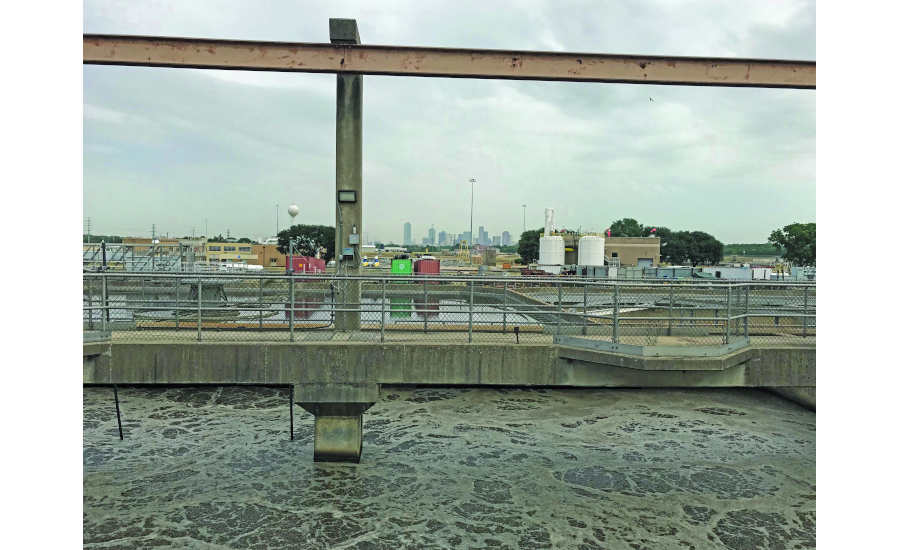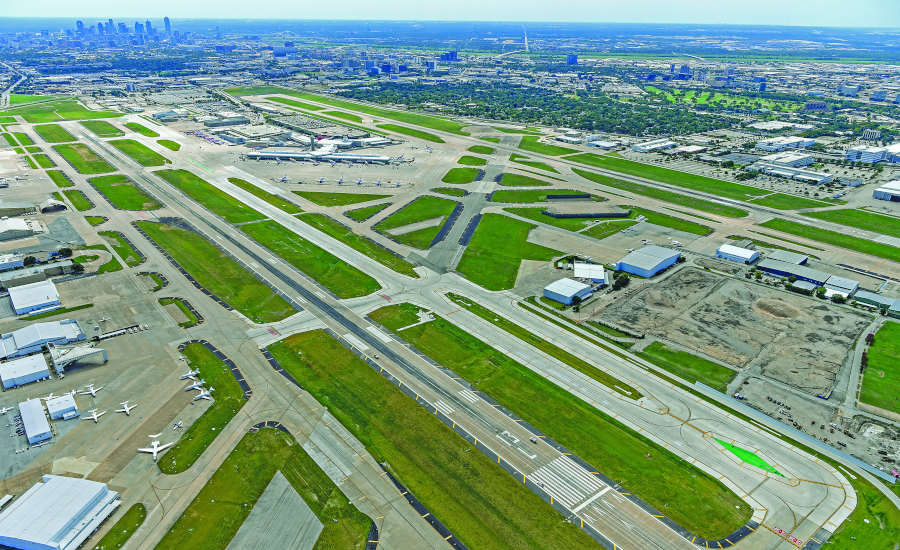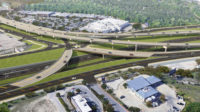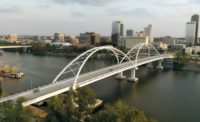Architecture and engineering firms continue to see mixed markets across the five-state region of Arkansas, Louisiana, Mississippi, Oklahoma and Texas. Being able to adapt to constantly evolving challenges amid the pandemic has proved vital to remaining successful.
There was a mix of gains and losses throughout ENR Texas & Louisiana’s annual Top Design Firms ranking. The top 100 firms on the list posted $7.35 billion in regional revenue for 2020, down from the $7.92 billion reported by last year’s top 100.
Some of the most significant drops in revenue were seen by firms that deliver projects for the petroleum industry. S&B Engineers & Contractors reported 2020 revenue of $359.68 million, compared with $751.42 million for 2019. Burns & McDonnell, which topped last year’s ranking, was second this year with $392.6 million in 2020 revenue, compared with $850.4 million in 2019.
“When COVID-19 emerged more than a year ago, the change in our markets was drastic, especially in the oil and gas business and the airline and airport business. In turn, we pivoted resources to those markets that were hot during the past year—logistics, food and consumer products, and mission critical,” explains Leslie Duke, president and general manager of Burns & McDonnell’s Houston office. “The pandemic has affected nearly every business in the United States, resulting in the worst unemployment rate since the Great Depression.”
But the firm’s diversified service offerings helped it survive the ups and downs of the market, she adds, noting that Burns & McDonnell “learned to pivot in the last year—in a stronger way than ever before. As the markets shift, so do our teams,” Duke says. “The market had been shifting to home delivery, and we have been investing in hiring those skills to take advantage of the changes in those markets.”
|
Related Link
|

Water Rehab: Improvements to the Dallas Central Wastewater Treatment Plant, led by Garver, will optimize and rehabilitate the activated sludge process.
This effort to diversify suggests the firm has “always been prepared to pivot as markets evolve, but the experience in many industries has allowed us to develop unique solutions to our customers’ challenges,” she says. In 2020, the company’s team in this region “supported more than 3,000 projects, resulting in nearly $1.1 billion in revenue,” Duke adds.
“The pandemic has affected nearly every business in the United States, resulting in the worst unemployment rate since the Great Depression.”
—Leslie Duke, President and General Manager, Houston, Burns & McDonnell
Burns & McDonnell has seen its markets rebound since the fourth quarter of 2020, and “we had our strongest sales quarter ever in the fourth quarter. We anticipate growing globally as a firm by 10% in 2021,” Duke says.
Strength in transportation projects throughout the pandemic helped bolster design firms serving that sector. WSP and HDR saw their 2020 revenue keep pace with 2019, and LJA Engineering’s revenue hit $289.1 million in 2020, a rise of about $32 million over the prior year.
Meanwhile, AECOM rose two spots to top this year’s ranking with $437.5 million in 2020 regional revenue, up from $402.63 million in 2019.
“AECOM was able to pivot to a work from home environment in short order and promptly addressed the IT infrastructure upgrades required to support our employees and our clients,” says Wendy Lopez, senior vice president and Texas executive at AECOM. “Our ability to efficiently and quickly move into the virtual world proved to steady our business and expand it with additional services to our existing customer base.”
AECOM is serving as lead designer on the $1.73-billion I-635 LBJ East design-build project, alongside a Fluor/Balfour Beatty construction joint venture, to improve mobility and reduce congestion in a key Dallas commuter corridor.
“The original plan was that this project would leverage 39 offices across AECOM—37 in the U.S. and two in Europe—but instead the project took shape in 600 homes, between AECOM and subconsultant staff,” Lopez says.
While the water and highway/bridge transportation infrastructure markets have stayed strong, “we are now seeing signs of the aviation market coming back,” Lopez says. “In addition, the water resource market was strong and growing, with specific strides in hydrology in both Texas and Louisiana. We’ve also increased our projects for coastal protection systems.”
The firm continues to work on major programs with the Coastal Protection and Restoration Authority on ecological restoration of the Louisiana coast in addition to furthering Louisiana’s Watershed Initiative to model and set standards for the entire state, Lopez adds.
North Little Rock-based Garver is seeing similar trends across the markets it serves, primarily transportation, water/wastewater and aviation design sectors. The firm grew its regional revenue by nearly $28 million in 2020 to reach $151.15 million, also boosting its rank from No. 22 in 2020 to No. 16 in 2021.
“The rebound in aviation passenger traffic was faster than modeled, and we are continuing to experience growth in all market sectors,” says Jeff Sober, Garver’s director of water services. “Municipal water and wastewater work has stayed very strong, especially in this region, which is adding new population every single day, and has a very low housing inventory.”
One of the firm’s recent projects included improvements to the Dallas Central Wastewater Treatment Plant to optimize and rehabilitate the activated sludge process, Sober says. Another is the design of the new greenfield Wilbarger Wastewater Treatment Plant for the city of Pflugerville. Garver is also conducting the Ports to Plains Feasibility Study for the Texas Dept. of Transportation, “one of the largest corridor studies ever conducted, including over 1,000 miles of proposed highway,” Sober says.
Garver was expecting 2020 to be a record year ahead of the pandemic, and that projection held true, Sober adds. “We were able to continue our successful growth across the region by remaining flexible under all circumstances and going above and beyond to respond to clients and meet them at their comfort level of dealing with the pandemic. Our response was not a one size fits all, and that has led to revenue growth in the region over the last year.”
Another transportation-focused firm that has fared well is HNTB, which drew in $156.84 million across the region last year, compared with $145.19 million in 2019.
“Our focus is on taking care of our employees, protecting our culture by being back in the office together and continuing to be nimble to respond to our clients’ needs.”
—Jeff Sober, Director of Water Services, Garver
“Like so many in our industry, we needed to find ways to be nimble as a result of the COVID-19 pandemic, not only in terms of our continuity of operations internally, but also doing all we could to assist our clients as they worked through these unforeseen challenges,” says Chris Price, central division president at HNTB. “Transitioning to the virtual environment is something that our teams and offices across the region quickly adapted to and allowed for the opportunity to continue moving vital transportation infrastructure projects forward. By leveraging technology, such as our public involvement management application, important project steps were able to move forward in a seamless fashion.”
At the end of 2020, two of HNTB’s transit hub projects reached completion. Houston METRO’s Northwest Transit Center was completed in December; HNTB provided planning and final design services as well as construction phase support for the project, which provides “universal accessibility” to riders with two platforms with 20 bays for local commuter buses and a third bay dedicated to METRO’s BRT Silver Line. HNTB served as engineer of record for Capital Metro’s Downtown Station project in Austin, which opened in October. It includes four platforms to improve MetroRail service and has created a public plaza tying transit together with the local convention center and surrounding businesses.
HNTB also served as lead designer and provided public involvement and construction engineering support to the Texas Dept. of Transportation’s El Paso District to improve traffic flow and enhance safety on this corridor, which averages approximately 120,000 vehicles per day.
“We are seeing improvements and more activity in the DOT and transit sectors, particularly in the construction management phase of the project life cycle,” Price says.
General building design firm Gensler fell back seven spots to 17th on this year’s ranking, with regional revenue of $149.9 million in 2020, down $38.6 million from the previous year. The Gensler team notes that maintaining, building and strengthening business relationships with both existing and new clients has been the key to its success throughout the pandemic.
Gensler’s Austin office is continuing work on Q2 Stadium and St. David’s Performance Center—the home and training facility for Austin’s first professional sports team, Austin FC, a Major League Soccer franchise. The stadium is expected to open this summer. Another project is the University of Texas at Austin’s Moody Center Basketball and Events Arena, which will serve as a sports and live music venue when it opens in 2022. Both projects are targeting LEED Silver certification.
To address an atmosphere of heightened anxiety and isolation among its team, Gensler established communication protocols to ensure transparency and promote community between employees and clients. In addition, the firm established an open-door policy, encouraging employees to meet with regional leadership to share concerns about the pandemic and its impact on home and work life.
And as companies begin to transition back to offices, “Gensler anticipates more organizations will rethink their workplaces based on experiences and learnings from the past year. Collectively, we are reimagining the future of work with flexibility, wellness, practical amenities and a shift in expectations in mind,” the firm says.

Airport Work: One of Garver’s recent jobs is the Dallas Love Field Crossfield Taxiway Construction project, which provides new taxiways.
Gensler’s team also believes the lifestyle market sector will undergo a major reset moving forward as the pandemic has “transformed retail, restaurants, hotels and mixed-use destinations around the world,” which is prompting these industries to “pivot away from single-use facilities to a hybrid model with a mix of offerings. Establishing meaningful, authentic consumer connections and new concepts that restore our sense of closeness and community and deliver accessibility for everyone will define this next phase of recovery.”
Looking ahead, firms are coming up with new ways to address challenges that will come with working in a post-pandemic environment.
Duke notes that Burns & McDonnell is constantly trying to understand how to be even more efficient and effective with communications, processes and execution of projects. “We are using technology to make it easier for clients to see their projects and to provide a platform for dialogue and communication between builders, architects, designers and owners,” she says. “These visual tools also are helping build trust that we are building what clients are seeing. The goal overall is to enhance communication and create a smooth, efficient process for everyone.”
AECOM is launching several new initiatives to help guide how people work post-pandemic. One is called Workplace of the Future, in which the firm “is designing more flexible ways of working that better leverage our investments in technology and cloud computing platforms and further optimize our overhead costs through a reduced real estate footprint,” Lopez says. “We are also advancing initiatives to enable the digital delivery of our work by establishing best practices and governance protocols for the digital reuse of core elements of the design process.”
Sober remains optimistic about the market outlook. “Our focus is on taking care of our employees, protecting our culture by being back in the office together and continuing to be nimble to respond to our clients’ needs.”
Meanwhile, several firms note that President Biden’s proposed transportation infrastructure package in the American Jobs Plan would be a great way to help the industry move forward.
“We are hopeful the ongoing discussions at the federal level as it relates to a large-scale infrastructure package will translate to an influx of new funding,” Price says. “We are working closely with our clients to do whatever we can to assist them in obtaining the greatest value possible from funding, including planning around the timing and readiness of projects if or when funding becomes available.”
Gensler notes that its team is “coming back to a changed world, and our job is to stay at the forefront of purpose-driven design for buildings and spaces that fully support the human experience. Taking care of our clients and employees remains another top priority. Our firmwide, regional and local leaders continue to stay engaged with clients and our people, sharing insights and thought leadership to prepare them for a post-COVID world, setting the stage for a successful recovery.”






Post a comment to this article
Report Abusive Comment